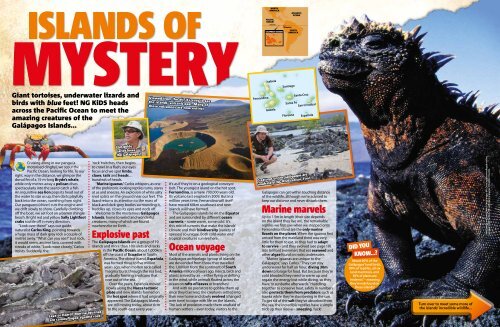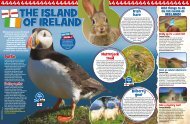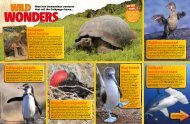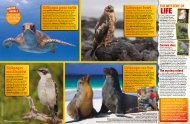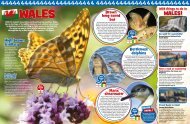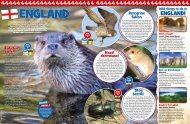109 NGK0315galapagos1-2.v8
- No tags were found...
You also want an ePaper? Increase the reach of your titles
YUMPU automatically turns print PDFs into web optimized ePapers that Google loves.
NORTH<br />
AMERICA<br />
PACIFIC<br />
OCEAN<br />
EQUATOR<br />
ATLANTIC<br />
OCEAN<br />
ECUADOR<br />
SOUTH<br />
GALÁPAGOS ISLANDS AMERICA<br />
Isabela<br />
Santiago<br />
Giant tortoises, underwater lizards and<br />
birds with blue feet! NG KiDS heads<br />
across the Pacific Ocean to meet the<br />
amazing creatures of the<br />
Galápagos Islands...<br />
Viewed from the air, it’s easy to see<br />
the islands’ volcanic past. Many of<br />
these volcanoes are now extinct<br />
Fernandina<br />
Isabela<br />
Santa Cruz<br />
Santa Fe<br />
San Cristóbal<br />
Floreana<br />
Española<br />
Our guide<br />
Carlos loves<br />
the Galápagos!<br />
Cruising along in our panga (a<br />
motorised dinghy), we scour the<br />
Pacific Ocean, looking for life. To our<br />
right, way in the distance, we glimpse the<br />
dorsal fin of a 15-m-long Bryde’s whale,<br />
while only metres away a pelican dives<br />
spectacularly into the sea to catch a fish.<br />
An inquisitive sea lion pops its head out of<br />
the water to size us up, then darts playfully<br />
back into the ocean, vanishing from sight.<br />
Our panguero (driver) cuts the engine and<br />
we drift slowly to shore. Carefully climbing<br />
off the boat, we set foot on a barren shingle<br />
beach. Bright red and yellow Sally Lightfoot<br />
crabs scuttle off in every direction.<br />
“Look over there!” says our guide,<br />
naturalist Carlos King, pointing towards<br />
a huge mass of dark grey rock a couple of<br />
metres away. “What can you see?” Just rock,<br />
it would seem, ancient lava, covered with<br />
streaks of white. “Look more closely,” Carlos<br />
insists. Suddenly, the<br />
Lava or lizard? Marine iguanas<br />
are camouflaged against rock!<br />
‘rock’ twitches, then begins<br />
to crawl. In a flash, our eyes<br />
focus and we spot limbs,<br />
claws, tails and heads…<br />
hundreds of heads.<br />
“Marine iguanas,” Carlos whispers, as one<br />
of the prehistoric-looking reptiles turns, stares<br />
at us and sneezes. An explosion of white salty<br />
snot splats on the ground near our feet. The<br />
lizard returns its attention to the mass of<br />
black and dark-grey bodies surrounding it,<br />
huddles up, closes its eyes and nods off.<br />
Welcome to the mysterious Galápagos<br />
Islands, home to weird and wonderful<br />
creatures, many of which are found<br />
nowhere else on Earth…<br />
Explosive past<br />
The Galápagos Islands are a group of 19<br />
islands and more than 100 islets and rocks<br />
in the Pacific Ocean, about 1,000km<br />
off the coast of Ecuador in South<br />
America. The oldest island, Española,<br />
was formed three to five million<br />
years ago, when molten rock called<br />
‘magma’ burst through the sea bed,<br />
gradually forming a volcano that<br />
rose out of the sea.<br />
Over the years, Española moved<br />
slowly along the Nazca tectonic<br />
plate and new islands formed on<br />
the hot spot where it had originally<br />
appeared. The Galápagos Islands<br />
are still moving today, about 6cm<br />
to the south-east every year –<br />
it’s as if they’re on a geological conveyor<br />
belt. The youngest island on the hot spot,<br />
Fernandina, is a mere 700,000 years old.<br />
Its volcano last erupted in 2009. But in a<br />
million years time, Fernandina will itself<br />
have moved 60km southeast and new<br />
islands will have formed.<br />
The Galápagos Islands lie on the Equator<br />
and are surrounded by different ocean<br />
currents – some warm, some cold. It’s<br />
this mix of currents that make the islands’<br />
climate and their biodiversity (variety of<br />
species) so unique. Both cold-water and<br />
tropical creatures survive here.<br />
Ocean voyage<br />
Most of the animals and plants living on the<br />
Galápagos archipelago (group of islands)<br />
are descended from those that travelled<br />
the 1,000km from the continent of South<br />
America millions of years ago. Insects, birds and<br />
plants arrived by air – either flying or drifting<br />
in the wind, while animals floated across the<br />
ocean on rafts of leaves or branches!<br />
And with no predators to gobble them up<br />
once they’d arrived, the creatures settled into<br />
their new home and slowly evolved (changed<br />
over time) to cope with life on the islands.<br />
The lack of predators made them unafraid of<br />
human settlers – even today, visitors to the<br />
Creatures on the Galápagos are<br />
unafraid of NG KiDS’ editor, Tim!<br />
Galápagos can get within touching distance<br />
of the wildlife, although we’re advised to<br />
keep our distance and never disturb them.<br />
Marine marvels<br />
Up to 1.5m in length (their size depends<br />
on the island they live on), the remarkable<br />
reptiles we first saw when we stepped onto<br />
Fernandina Island are the only marine<br />
lizards on the planet. When the iguanas first<br />
arrived from the mainland there was very<br />
little for them to eat, so they had to adapt<br />
to survive – and they evolved (see page 19)<br />
into brilliant swimmers that eat seaweed and<br />
other algae found on rocks underwater.<br />
“Marine iguanas are unique to the<br />
Galápagos,” says Carlos. “They can stay<br />
underwater for half an hour, diving 30m<br />
down to forage for food. But because they’re<br />
cold blooded they need to warm up and<br />
regain the energy lost while diving, so they<br />
have to sunbathe afterwards.” Huddling<br />
together to conserve heat, safety in numbers<br />
also protects them from predators such as<br />
hawks while they’re slumbering in the sun.<br />
To get rid of the salt they’ve absorbed from<br />
the sea, the incredible reptiles have a simple<br />
trick up their sleeve – sneezing. Yuck!<br />
DID YOU<br />
KNOW...?<br />
About 80% of the<br />
Galápagos’ land birds,<br />
90% of reptiles, all six<br />
land mammals, and<br />
38% of plants are<br />
‘endemic’ – meaning<br />
they’re only found on<br />
these islands!<br />
Turn over to meet some more of<br />
the islands’ incredible wildlife...<br />
Main image and aerial photo: Getty Images UK. Close-up of camouflaged marine<br />
iguanas © Tim Herbert. Tim with marine iguanas: Vincenzo Chiarello.


